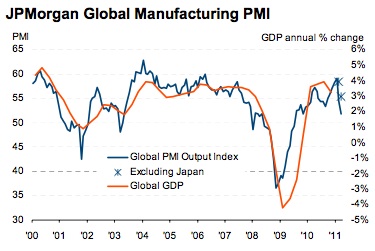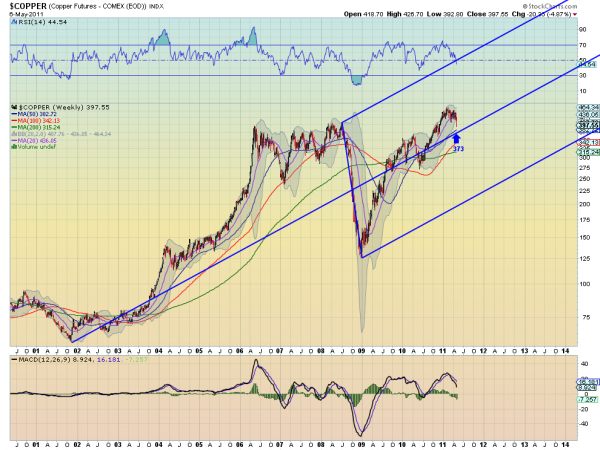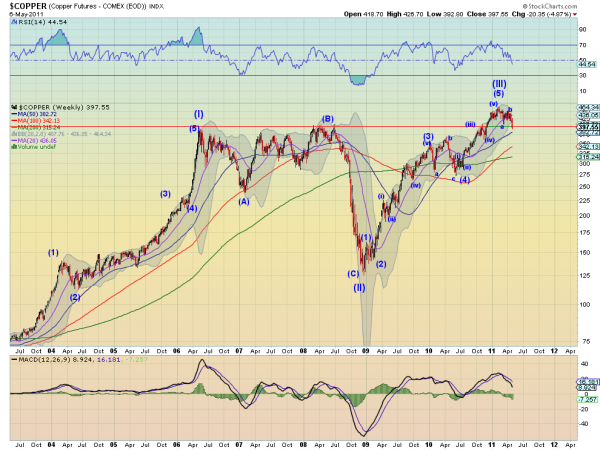Jack Barnes writes: For most of the past year, anything involving the U.S. dollar has been what traders like to refer to as a "one-way trade."
And with good reason: Over the past year, the U.S. currency has traded in only one direction - down.
Indeed, during the period in question the dollar is down 8.3% against the British pound, 11.65% against European euro and 14.2% against the Japanese yen. On a year-over-year basis, the biggest gains against the dollar have been notched by the Australian dollar (20%) and the Swiss franc (26.7%).
This freefall by the greenback is part of the reason that gold and silver soared to new records and commodity prices have zoomed during the past year (before their decline in the past week).
But here's the thing: This nosedive by the dollar is ending - with a U-turn that's going to send the U.S. currency into a zooming climb.
Traders refer to this abrupt reversal-of-fortune pattern as an "inflection point."
And those traders recognize this about-face in the U.S. dollar for exactly what it is: A windfall profit opportunity for investors who understand just how to play it.
Anatomy of an "Inflection Point"
Since June, when it achieved its most recent peak, the U.S. dollar - as measured by the benchmark U.S. Dollar Index (DXY) - plunged more than 14%.
The greenback has rallied a bit in the early part of this month. But there are much bigger gains to come - the kind of gains associated with a true financial asset "inflection point."
To understand the about-face that we're about to experience, it's important to understand there were essentially five factors that tipped the greenback over into its nose-dive. Those factors included:
•A Debt-Intent Central Bank: A big part of the demise in the near-term value of the U.S. dollar was the continuation of a U.S. Federal Reserve monetary policy that caused the central bank's balance sheet to balloon from $850 billion in 2007 to a new all-time high of $2.669 trillion in April of this year. Indeed, the Fed's balance sheet grew by $340 billion during the last year alone.
•A Debt-Addicted Federal Government: Global interest in the dollar was further diminished by a U.S. federal debt load that soared from $8.9 trillion on Aug.1, 2007 (when the first signs of distress really hit the financial markets) to $14.298 trillion just 3.7 years later.
•A New Market Rival: Thanks to some market machinations by China's government -which has caused that country's yuan (renminbi) currency to rise slowly against the U.S. dollar while dropping against China's other trading partners - the U.S. currency has grown progressively weaker. This has been driven by Chinese interventions in the so-called "FX" (foreign-exchange) markets on an almost-daily basis.
•A Global Leadership Vacuum From Washington: It's a sad-but-true fact that the United States no longer commands the respect that it once did on the world stage. And much of that is the fault of Washington, which has lost touch with what's important both here at home and abroad. This lack of respect has helped diminish the "reserve status" of the U.S. dollar, leading to a bit of a run on the American currency.
•The ‘Mortage-Backed Securities" on the Fed's Balance Sheet Fueled the Real Dollar Collapse: That real dollar collapse arrived as the implications of the Fed's monetization of MBS holdings hit home. In simple terms, people around the world have felt that America's central bank was debasing its own currency with the purchases of mortgage-backed securities (MBS) from U.S. banks that had been left holding the bag for some horrid trades. The Fed handed those bankers freshly minted U.S. Treasury bonds.
With each of these preceding five factors at work, it's little wonder that the United States was essentially debasing its own currency - leaving the leaders of other countries to watch as they scratched their heads in rueful disbelief.
In reality, Wall Street has been able to talk Washington into just about anything it needed - even though most of these schemes robbed Main Street consumers of their middle-class buying power. The obvious debasement of the American currency reached the point internationally that investors wanted to own anything but the U.S. dollar.
The accompanying graphic illustrates how investors have abandoned the dollar as they fled into other asset classes over the past year.
You only have to look at the results for a few seconds to see that the reserve status of the U.S. dollar was being abrogated. It didn't hit the lows it reached during the depths of the global financial crisis but it got darned close.
Now, however, the inflection point is upon us.
Time For a Trend Reversal?
The reality of a "one-way" trade opportunity - which underscores the sharpness of an "inflection point" - is that they persist until they don't. I think of this as the "inflection moment," the point at which investors realize that they've ridden the trade as far as they can, meaning it's time to cash out and book their profits.
This is usually represented by a giant shift in investor sentiment. In the case of the U.S. dollar, it was the monetization of our national debt - to fund the deficit spending of the last two administrations - that destroyed the trust in the U.S. dollar. This single action, once boiled down, has carved off the U.S. dollar's buying power.
But now - with the dollar at a potential inflection point - should the Fed shift away from its currency-debasing policy, this could well prove to be the market bottom. That means the greenback will build on the early rebound move that we've already seen. Markets bottom when selling pressure abates.
At some point, the net selling pressure will abate as sellers run out of ammo, and the market switches to net buying pressure. It doesn't matter if it is FX, commodities, stocks or bonds. At the margin, trading is where real price discovery happens.
You can see the different signs showing up in different places, if you know where to look.
.Five Inflection-Point Signals
During my time as a hedge-fund manager, I discovered five indicators that, taken together, provide a pretty reliable signal that a dollar reversal - an inflection point - is at hand.
When viewed individually, these indicators aren't that significant. But when they all shift at once, it's a pretty powerful hint that a new trend is afoot - and that windfall-profit opportunities are there for the taking.
To anticipate a reversal in the current decline of the dollar, you should:
•Follow the U.S. Dollar Index (DXY): Despite its travails, the greenback remains the world's most-reliable reserve currency, which also makes it one of the very best indicators of raw market sentiment. If the index (as a proxy for the actual currency) establishes a bottom, you can bet change is afoot.
•Watch Commodity Exchange Margin Requirements: As volatility increases, something we normally see in advance of an "inflection point," exchanges will rein in risk by increasing margin requirements. As we've seen with silver - a commodity that stumbled after margin increases in recent weeks - these shifts in the regulations can have quite an impact on speculation and on prices - dampening both.
•Follow the (Big) Money: Pacific Investment Management Co. LLC's Bill Gross is the largest bond-fund manager in the world. Gross' buying or selling can get a market moving in a new direction quite easily. So when he opted to dump all his U.S. Treasury bonds recently, investors took note.
•Never Forget the Fed: When the U.S. Federal Reserve needs to change its direction, it will send out a plethora of independent Federal Reserve presidents, or governors, to reshape market expectations.
•Watch Dollar-Denominated Assets: The capital markets can be boiled down into a couple of major asset classes, which will trade either with - or against - one another. The U.S. dollar is the single-best example of this. Commodities are priced in dollars.
So let's look at each of these five in a bit more detail:
•The Dollar Index: When the dollar does start to strengthen, it will unfold over a period of months, giving you plenty of time to make your move. Commodities will be directly affected: As the dollar increases in value, the cost to purchase them should start to shrink. If you are an investor with a long-term outlook, a lot of damage can be done to your portfolio while you wait for the next commodity-bull-market-move to return.
•Commodity Margin Requirements: The Chicago Mercantile Exchange (Nasdaq: CME) changed margin rates on silver futures 10 times in the last six months or so. In early November, the CME Group's Comex Division permitted a leverage level ratio of 28-to-1 on futures contracts already held. Today, after five margin increases in silver in the last two weeks, the CME is now offering leverage of about 8-to-1. In my field, this is called "leverage compression," and it was likely one of the primary reasons that silver topped the way that it did - "spiking" up, and then down.
•Big Money Moves: PIMCO's Gross is in a unique position. He manages the world's largest bond fund, which has morphed into the world's largest mutual fund. The so-called "King of Bonds," as he was known during the "Great Bond Rally of 1983-2010," is now out of U.S. Treasuries. This is a "screaming Buy" alert to anyone who pays attention to the "big picture" in terms of top-down investing. In fact, at the end of April, the PIMCO Total Return A Fund (MUTF: PTTAX), was 4% short on U.S. Treasuries via swaps in that "world's largest bond mutual fund," according to Reuters. This extreme change in sentiment is a tacit illustration of his expectations for the direction of the U.S. Treasury yield curve over the near-term to medium-term time horizon. Historically, Gross has been great at calling inflection points in the market. The only way his trade will make sense is if the U.S. Federal Reserve makes a surprise quarter-point increase in the benchmark Federal Funds rate - which would set the stage for a long-term series of rate increases in the future. While 25 basis points is insignificant in the big picture, it is a major change in sentiment and one that would have serious implications for the future structure of the U.S. bond market.
•Never Forget the Fed: When the central bank decides to change its stance, markets will move. While hawks on the policymaking Federal Open Market Committee (FOMC) have started to sound off about a stronger U.S. dollar, this group lacks the votes, which has kept the market from fearing their comments. If and/or when the sentiment within the FOMC changes to favor an increase in rates (or even a "bias" in that direction), then all market biases will change. If you want an example, the best one to review is one from 1994, and the steady state of small, incremental increases that the market endured during the period. Stock prices were challenged, and bond values were hammered.
•Watch Dollar-Denominated Assets: If the dollar is in a downward-trading pattern, there is little reason to fear that your long commodity positions will be hurt. If the U.S. dollar changes direction, you can expect that the longer-term commodity-price trends will experience a change, too. That may not happen overnight. But "at the margin" all commodities are a "short" U.S. dollar trade, meaning they represent a bet against a rising dollar. In other words, if I am leveraged long gold, I am realistically making a leveraged short U.S. dollar trade.
Moves to Make Now
Now that we know what to look for, it's time to talk about how to profit - at least in a general sense. (Future stories in this Money Morning series, "The Inflection Point," will provide many specific dollar-rebound profit plays to help readers navigate this tricky stretch.) But for you to understand what we'll be talking about, you need an overview of the kinds of profit plays we'll be looking for and talking about.
When the U.S. dollar bottoms, you can expect to see commodities pull back in price. You can expect to see margins expand in businesses that consume high levels of raw commodities. International shipping companies should see their profit margins improve.
Investors, companies and governments around the world use U.S. dollars as their "reverse" currency. When the dollar changes direction, it impacts the economy of the whole world. In the near future, having reached this "inflection point," the dollar will change its bias direction. And when it does so, every investment or investment strategy that used to work in the global financial markets, no longer will.
Now is the time to prepare your portfolio to the coming change in bias - the inflection point. You'll be glad that you did.
See the original article >>















